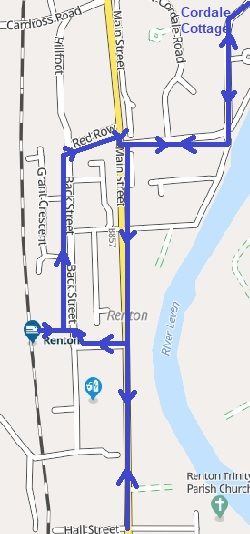The Renton Ramble Three
There can be few if any places in the World, where literally pivotal footballing history can be so concentrated, than Dunbartonshire's Renton. It was the village team, which, in 1875 by reaching the second ever Scottish Cup Final provided the first provincial challenge to Glasgow's place in Scottish football. Admittedly that final was lost but it would only be two season's later that Vale of Leven, the club from neighbouring Alexandria, would complete the task and for a while be predominant. However, Renton would regroup and from 1883 a new group of players would emerge its working-class streets and change football forever. If Vale of Leven can be said to have been the first, successful working-man's team then Renton, astoundingly already one hundred and thirty-five years ago, and after a five year incubation is the source of the modern game. Football might have been invented England but in and from 1888 both north and south of the border it was changed irrevocably. It was the year Renton first won the Scottish Cup for the second time and then beat England's West Bromwich Albion and Preston North End, that and the next season's winners of the English FA Cup with Preston also in 1889 first League Champions. And they did first of all by employing a new style of football developed specifically in the village and secondly with a group of fifteen or so young men, who emerged from a collection of then teaming streets that even today may be explored in a matter of minutes following our first Renton Ramble One.
But the flow of village talent did not stop there. Two more waves of young men emerged approximately five years apart over the next decade. Most were persuaded by English clubs to earn a living from football that was initially officially denied them in their own land but, as professionalism came to Scotland, other teams in our own game beyond Celtic came in to draw from the pool. And in doing so these younger products of Renton youth took the same new style now not only into the wider World but across our land. The Second Wave can be followed on Renton Ramble Two and streets of the Third Wave can be explored on-line below or using those notes in reality at a stroll on the ground.
So now, if your curiosity is again pricked, then here is the history that may start to bring it all to life.
Out of the station, to the T-junction you turn left into the upper part of Back St. There Andrew Mclean, brother of Duncan McLean, grew up, as did Johnny Murray and Jack Pryce. Andrew Mclean and Murray would stay with their village club. Murray and Pryce would be in the Renton team that lost the 1894 Scottish Cup Final along with a John, quite possibly the middle McLean brother. Pryce would go on to Hibernian and then South, notably Sheffield Wednesday.
Continue on to the second on the left, Red Row and take it to Main St., turning right, crossing and taking the first left into Stirling St.. That will give you access to Cordale Ave. half way up which, where Hannah Place, named for Andrew Hannah, stood Cordale House and presumably Cottage. It was the home of John Ritchie until his twenties, he being by then a Renton first-team stalwart.
Now backtrack to Main St. once more. There turn right and between Nos. 116 and 4 you will pass the teenage homes of John Crawford, who went to Blackburn, then David Gilfillan to Darwen, James McBride to Liverpool and Manchester City, Robert Duncan, who stayed at home, Donald Colman, to Motherwell and Aberdeen and Robert Glenn to Hibernian once more.
Here there was once the village's public park, before the creation of Tontine Park, from 1878 Renton F.C.'s ground, and the present day one across the road. Here is Trinity Place, once Church Place and, it is thought, Park Buildings and Park Terrace. The first was the home of Billy Fleming, who would go on to Partick Thistle, Sheffield United and Dundee amongst other. Park Buildings was where David Hannah was a teenager. He would be another to join Sunderland and Liverpool but also Arsenal. And Park Terrace was where Alex Brady stayed at aged ten, as did John Harvey, newly arrived from Glasgow and going on to ply his trade again at Sunderland plus Clyde and Newcastle, where he became a trainer of its great team of the 1910s.
And then, before it is back for walkers at least to the starting point at the station, the present and onward,. In doing so you pass where Harry Gardiner lived as a lad on Station St. itself. He went on to make eighty appearances for Bolton Wanderers. Alternatively there is perhaps enough time for a quick walk a quarter of a mile there and back southward to Tontine Park, Renton's ground from 1878 to 1922. The name survives as a street at the centre of a small housing-estate and on the way you will pass Hall St. on the right as Main St. becomes Lennox St.. Perhaps greatest Renton footballer of them all, Alex Jackson, would be born in the former and spent his childhood on the latter.
